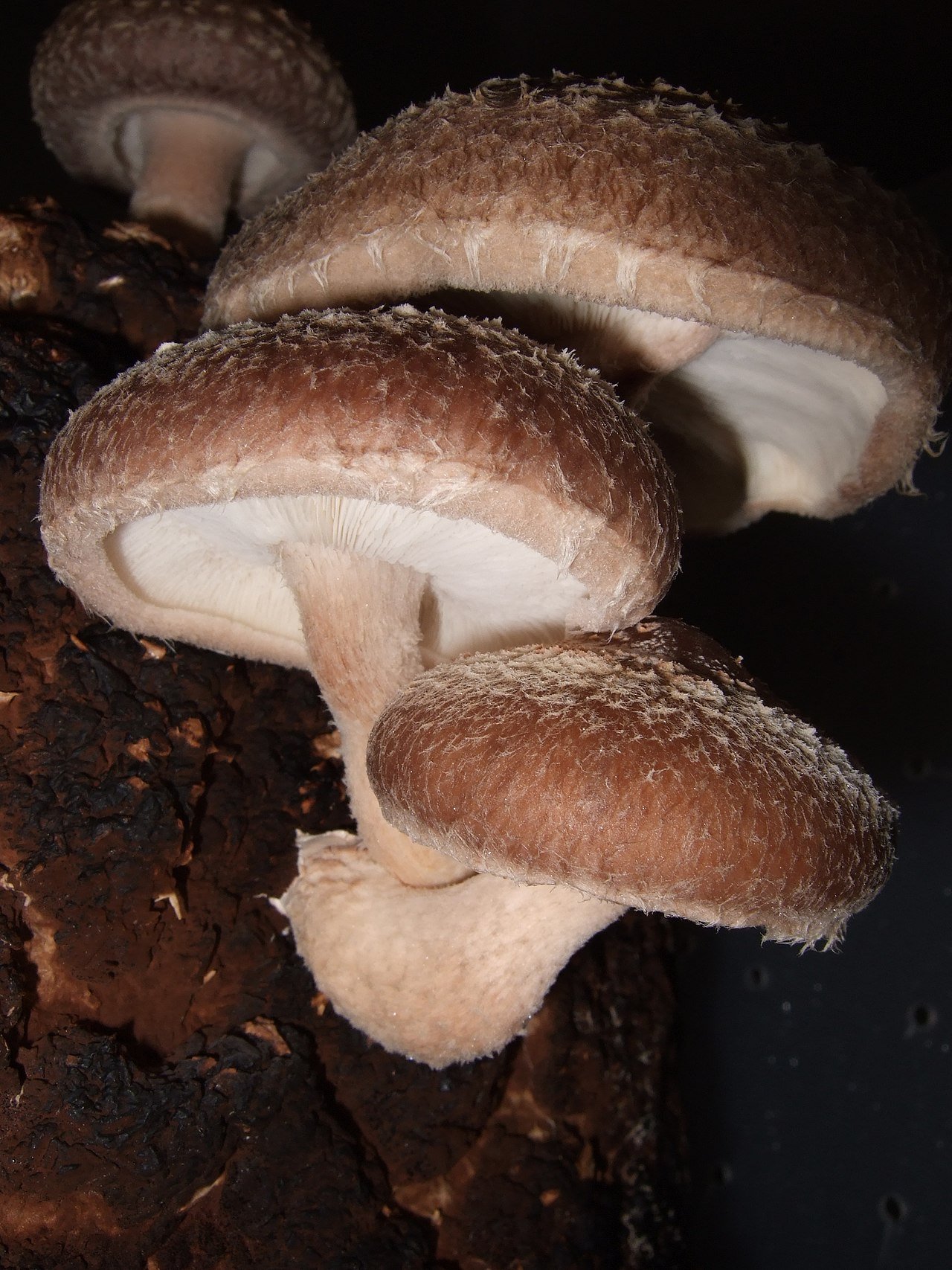
Lentinula edodes
SHIITAKE
History
The earliest known record of shiitake cultivation dates back to 1209, during the Song Dynasty in China. This makes it the oldest known cultivated mushroom. The name shiitake comes from the Japanese shii, the name of the tree it grew on, and take, for mushroom.
In Japan, the shiitake was cultivated by cutting down the shii tree (this is an oak relative) and leaning those logs against trees that were already growing shiitake or were known to contain shiitake spores. This was an early way to inoculate the logs with shiitake spores so that they could be grown for harvest.
Commercial production of shiitake mushrooms kicked off in the 1930s, and the mushrooms were grown on hardwood logs. Later they were grown on sterilized sawdust, which allowed for faster production. Today, shiitake is cultivated all over the world, either on artificial substrate, sawdust, or on hardwood logs, often oak logs. Shiitake mushrooms make up about a quarter of all cultivated mushrooms in the world.
These days, shiitake mushrooms are cultivated at scale by large mushroom growers, but they’re also grown by farmers seeking to make their forest land more productive. They can even be grown on your back deck or in your garden!
BIOLOGY
The shiitake is a gilled mushroom, and is made up of two main parts; the mycelia and the fruiting body. The mycelia are a branching hairlike structure that penetrates the substrate, in this case hardwood logs and trees, and provides nutrients to the organism. The fruiting body is the part that we harvest and eat as mushrooms!
The shiitake plays an important role in its ecosystem. It’s a decomposer, like most fungi, and it’s able to digest lignin, an organic polymer deposited in the cell walls of many plants that make them woody and rigid. This means that they decompose trees, clearing deadfall from the forest floor and returning vital nutrients to the soil.
Health and Flavor
Shiitake mushrooms (Lentinula edodes) are renowned for their medicinal and gourmet value, supported by scientific research.
Medicinal Benefits:
Immunomodulatory Effects: Shiitake mushrooms contain polysaccharides like lentinan, which have been shown to enhance immune function by stimulating the production of immune cells such as T cells and natural killer cells. This immunomodulatory activity may help improve the body's ability to fight infections and diseases.
Antioxidant Properties: Shiitake mushrooms are rich in antioxidants, including phenolic compounds and polysaccharides, which help neutralize free radicals in the body, reducing oxidative stress and inflammation. This antioxidant activity may contribute to their potential health benefits, including reducing the risk of chronic diseases like cancer and heart disease.
Antimicrobial Activity: Compounds found in shiitake mushrooms, such as lentinan and eritadenine, exhibit antimicrobial properties against various pathogens, including bacteria, viruses, and fungi. These compounds may help protect against infections and support overall immune health.
Gourmet Value:
Rich Flavor Profile: Shiitake mushrooms have a distinctive umami flavor with notes of earthiness and meatiness, making them a popular ingredient in various cuisines worldwide. Their robust flavor adds depth to dishes and makes them a versatile ingredient in both savory and vegetarian recipes.
Nutritional Value: Shiitake mushrooms are low in calories and fat but rich in protein, dietary fiber, vitamins (such as B vitamins like niacin, riboflavin, and vitamin D), and minerals (including potassium, phosphorus, and copper). They provide essential nutrients while adding flavor and texture to meals.
Culinary Versatility: Shiitake mushrooms can be cooked in various ways, including sautéing, stir-frying, grilling, roasting, and adding to soups, stews, and risottos. Their meaty texture and rich flavor make them a popular choice for vegetarian and vegan dishes as well as meat-based recipes.
Overall, shiitake mushrooms offer a combination of medicinal and gourmet benefits supported by scientific research, including immunomodulatory, antioxidant, and antimicrobial properties, as well as their rich flavor profile, nutritional value, and culinary versatility.
Where to Find Shiitake?
Finding shiitake mushrooms is possible through different channels. Dehydrated shiitakes, which offer concentrated flavor and a longer shelf life, are readily available at any asian market and require only rehydration with water.
Fresh shiitakes can often be found in select supermarkets or local farmers' markets, some mushroom farms and supermarkets even offer delivery services.
For those interested in a more hands-on approach, growing shiitake mushrooms at home is a viable option. With a history of cultivation spanning centuries, shiitakes thrive in outdoor environments and can be cultivated with relative ease.
Whether obtained from markets, farms, or grown at home, shiitake mushrooms can enhance a variety of dishes with their distinctive flavor profile.



